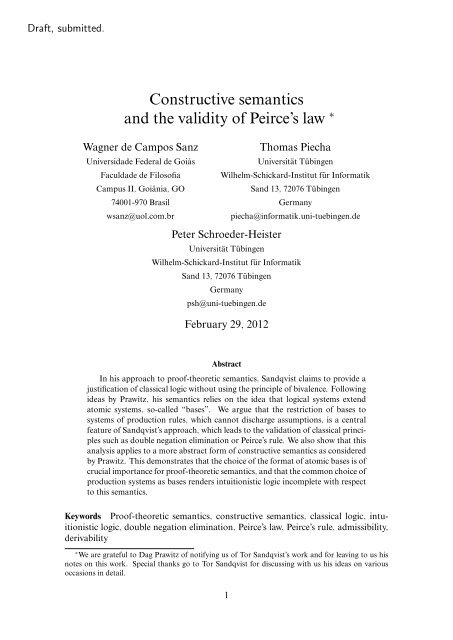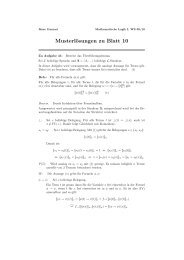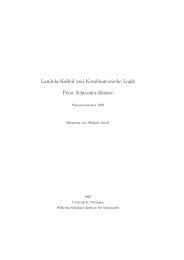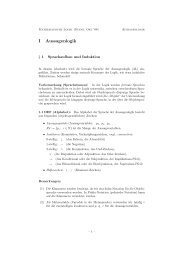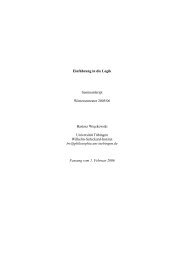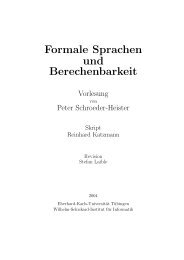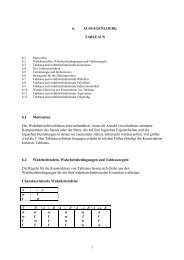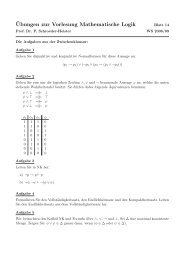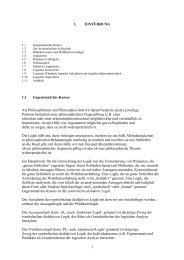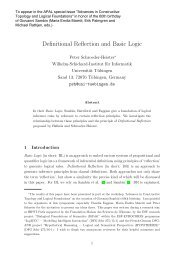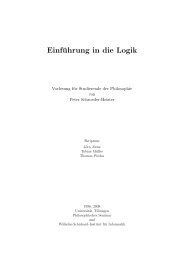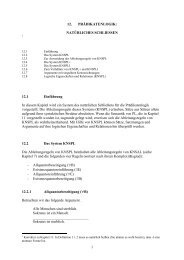Constructive semantics and the validity of Peirce's law
Constructive semantics and the validity of Peirce's law
Constructive semantics and the validity of Peirce's law
Create successful ePaper yourself
Turn your PDF publications into a flip-book with our unique Google optimized e-Paper software.
Draft, submitted.<br />
<strong>Constructive</strong> <strong>semantics</strong><br />
<strong>and</strong> <strong>the</strong> <strong>validity</strong> <strong>of</strong> Peirce’s <strong>law</strong> ∗<br />
Wagner de Campos Sanz<br />
Universidade Federal de Goiás<br />
Faculdade de Filos<strong>of</strong>ia<br />
Campus II, Goiânia, GO<br />
74001-970 Brasil<br />
wsanz@uol.com.br<br />
Thomas Piecha<br />
Universität Tübingen<br />
Wilhelm-Schickard-Institut für Informatik<br />
Peter Schroeder-Heister<br />
Universität Tübingen<br />
S<strong>and</strong> 13, 72076 Tübingen<br />
Germany<br />
piecha@informatik.uni-tuebingen.de<br />
Wilhelm-Schickard-Institut für Informatik<br />
S<strong>and</strong> 13, 72076 Tübingen<br />
Germany<br />
psh@uni-tuebingen.de<br />
February 29, 2012<br />
Abstract<br />
In his approach to pro<strong>of</strong>-<strong>the</strong>oretic <strong>semantics</strong>, S<strong>and</strong>qvist claims to provide a<br />
justification <strong>of</strong> classical logic without using <strong>the</strong> principle <strong>of</strong> bivalence. Following<br />
ideas by Prawitz, his <strong>semantics</strong> relies on <strong>the</strong> idea that logical systems extend<br />
atomic systems, so-called “bases”. We argue that <strong>the</strong> restriction <strong>of</strong> bases to<br />
systems <strong>of</strong> production rules, which cannot discharge assumptions, is a central<br />
feature <strong>of</strong> S<strong>and</strong>qvist’s approach, which leads to <strong>the</strong> validation <strong>of</strong> classical principles<br />
such as double negation elimination or Peirce’s rule. We also show that this<br />
analysis applies to a more abstract form <strong>of</strong> constructive <strong>semantics</strong> as considered<br />
by Prawitz. This demonstrates that <strong>the</strong> choice <strong>of</strong> <strong>the</strong> format <strong>of</strong> atomic bases is <strong>of</strong><br />
crucial importance for pro<strong>of</strong>-<strong>the</strong>oretic <strong>semantics</strong>, <strong>and</strong> that <strong>the</strong> common choice <strong>of</strong><br />
production systems as bases renders intuitionistic logic incomplete with respect<br />
to this <strong>semantics</strong>.<br />
Keywords Pro<strong>of</strong>-<strong>the</strong>oretic <strong>semantics</strong>, constructive <strong>semantics</strong>, classical logic, intuitionistic<br />
logic, double negation elimination, Peirce’s <strong>law</strong>, Peirce’s rule, admissibility,<br />
derivability<br />
∗ We are grateful to Dag Prawitz <strong>of</strong> notifying us <strong>of</strong> Tor S<strong>and</strong>qvist’s work <strong>and</strong> for leaving to us his<br />
notes on this work. Special thanks go to Tor S<strong>and</strong>qvist for discussing with us his ideas on various<br />
occasions in detail.<br />
1
1 Introduction<br />
In Dummett-Prawitz-style pro<strong>of</strong>-<strong>the</strong>oretic <strong>semantics</strong> <strong>the</strong> meaning <strong>of</strong> a proposition is<br />
given in terms <strong>of</strong> what conditions must be fulfilled in order to assert <strong>the</strong> proposition.<br />
If <strong>the</strong> condition to assert a proposition is <strong>the</strong> possession <strong>of</strong> a pro<strong>of</strong>, <strong>the</strong>n a constructive<br />
<strong>semantics</strong> requires a description <strong>of</strong> what are pro<strong>of</strong>s <strong>of</strong> basic propositions <strong>and</strong> <strong>of</strong> what<br />
are pro<strong>of</strong>s <strong>of</strong> logically complex propositions. The description is usually given as an<br />
inductive definition. Among o<strong>the</strong>rs, Dummett [1] <strong>and</strong> Prawitz [5, 6, 7] are references<br />
for this approach (for an overview see [11, 13]). Recently, S<strong>and</strong>qvist [10] proposed a<br />
<strong>semantics</strong> for logically complex propositions, which is closely related to constructive<br />
<strong>semantics</strong>, <strong>and</strong> which takes <strong>the</strong> form <strong>of</strong> an inductive definition too. It is <strong>of</strong> special<br />
interest as it is intended to yield a justification <strong>of</strong> classical logic without making use<br />
<strong>of</strong> <strong>the</strong> principle <strong>of</strong> bivalence.<br />
We focus on <strong>the</strong> logical constant <strong>of</strong> implication. The implicational fragment {⊃}<br />
<strong>of</strong> natural deduction for minimal logic NM (<strong>and</strong> also for intuitionistic logic NI) is<br />
given by <strong>the</strong> following introduction <strong>and</strong> elimination rules:<br />
[ϕ]<br />
.<br />
� (⊃I)<br />
ϕ ⊃ �<br />
ϕ ϕ ⊃ � (⊃E)<br />
�<br />
These rules also hold in <strong>the</strong> fragment {⊃} <strong>of</strong> natural deduction for classical logic NK,<br />
although <strong>the</strong>y do not suffice to obtain all classical <strong>the</strong>orems in this fragment. Classical<br />
<strong>law</strong>s like Peirce’s <strong>law</strong> ((ϕ ⊃ �) ⊃ ϕ) ⊃ ϕ are provable when one <strong>of</strong> <strong>the</strong> following two<br />
versions <strong>of</strong> Peirce’s rule is added:<br />
[ϕ ⊃ �]<br />
.<br />
ϕ<br />
ϕ<br />
(ϕ ⊃ �) ⊃ ϕ<br />
ϕ<br />
Each version can be derived from <strong>the</strong> o<strong>the</strong>r by using (⊃I) <strong>and</strong> (⊃E). Let NP be NM<br />
plus (one version <strong>of</strong>) Peirce’s rule. The addition <strong>of</strong> ex falso quodlibet<br />
⊥<br />
ϕ<br />
to NM gives NI, <strong>and</strong> <strong>the</strong> addition <strong>of</strong> it to NP gives NK. Peirce’s rule is not justifiable<br />
constructively, since its addition to NI allows to prove tertium non datur, which is<br />
normally rejected as being non-constructive 1 .<br />
2 S<strong>and</strong>qvist’s <strong>semantics</strong> for classical logic<br />
S<strong>and</strong>qvist [10] has proposed a semantic justification <strong>of</strong> classical logic, which does not<br />
make use <strong>of</strong> <strong>the</strong> principle <strong>of</strong> bivalence, for <strong>the</strong> rule <strong>of</strong> double negation elimination<br />
for <strong>the</strong> fragment {⊃, ⊥, ∀}. Once double negation elimination is established, <strong>the</strong><br />
1 See Heyting [2], p. 103f.<br />
2
o<strong>the</strong>r logical constants can be defined, <strong>and</strong> <strong>the</strong> justification becomes a justification for<br />
classical logic without using <strong>the</strong> principle <strong>of</strong> bivalence. S<strong>and</strong>qvist considers bases B<br />
which are sets <strong>of</strong> basic sequents, that is, relations between finite sets <strong>of</strong> basic sentences<br />
<strong>and</strong> basic sentences, where basic sentences are formulas containing nei<strong>the</strong>r logical<br />
constants nor free variables. In <strong>the</strong> following, basic sentences are also called atoms.<br />
We are not considering quantifiers, as <strong>the</strong>y are not relevant to <strong>the</strong> arguments put<br />
forward here. This means that we can consider atoms to be propositional variables.<br />
The language <strong>of</strong> all bases is <strong>the</strong> same, that is, <strong>the</strong> set <strong>of</strong> all atoms. A basis B can thus<br />
be viewed as a set <strong>of</strong> atomic inferences, that is, <strong>of</strong> production rules<br />
p1 . . . pn<br />
pn+1<br />
where <strong>the</strong> pi are atoms. For a given basis B S<strong>and</strong>qvist <strong>the</strong>n defines inductively a<br />
relation �B, called ‘valid inferability’, between finite sets 2 <strong>of</strong> sentences in general <strong>and</strong><br />
sentences in general (ibid., p. 213, our numbering; we omit <strong>the</strong> clause for ∀):<br />
Definition 1.<br />
Where p is a basic sentence: �B p ⇐⇒ Every set <strong>of</strong> basic sentences<br />
closed under B contains p<br />
Where Γ is non-empty: Γ �B ϕ ⇐⇒ �C ϕ for every C ⊇ B<br />
such that �C � for every � ∈ Γ<br />
(1)<br />
(2)<br />
�B ϕ ⊃ � ⇐⇒ ϕ �B � (3)<br />
�B ⊥ ⇐⇒ �B p for every basic sentence p (4)<br />
An inference ϕ1 . . . ϕn<br />
ϕ<br />
holds for B if ϕ1, . . . , ϕn �B ϕ. The inference is considered<br />
logically valid if ϕ1, . . . , ϕn �B ϕ for every B. If Γ �B ϕ holds for every B, <strong>the</strong>n we<br />
also speak <strong>of</strong> logical consequence, denoted by Γ � ϕ. A justification <strong>of</strong> <strong>the</strong> inference<br />
<strong>of</strong> double negation elimination consists thus in showing that this inference is a logical<br />
consequence. This is stated in his main lemma as follows (ibid., p. 216), where <strong>the</strong><br />
choice <strong>of</strong> <strong>the</strong> basis B is arbitrary:<br />
Lemma 4 (Double negation). (ϕ ⊃ ⊥) ⊃ ⊥ �B ϕ. 3<br />
The pro<strong>of</strong> <strong>of</strong> Lemma 4 begins as follows (ibid., p. 216):<br />
Pro<strong>of</strong>. It suffices to prove <strong>the</strong> result for basic ϕ; given Lemma 3, non-basic<br />
applications <strong>of</strong> double-negation elimination can be reduced to basic ones<br />
in <strong>the</strong> manner, mutatis mut<strong>and</strong>is, <strong>of</strong> Prawitz [4, pp. 39–40].<br />
Lemma 3 (ibid., p. 216) states that <strong>the</strong> usual introduction <strong>and</strong> elimination rules for<br />
<strong>the</strong> fragment {⊃, ∀} hold for <strong>the</strong> inferential relation �B (as given in his Definition 1).<br />
Lemmas 3 <strong>and</strong> 4 establish that Γ �B ϕ whenever ϕ is a classical consequence <strong>of</strong> Γ<br />
(ibid., p. 217), from which S<strong>and</strong>qvist’s Theorem 2 (expressing <strong>the</strong> justification <strong>of</strong><br />
classical logic) follows directly (ibid., p. 214):<br />
2 S<strong>and</strong>qvist considers only finite sets <strong>of</strong> assumptions.<br />
3 More precisely, he uses a consequence relation referring to substitutions for free variables, which<br />
is not significant in <strong>the</strong> context <strong>of</strong> propositional logic considered here.<br />
3
Theorem 2 (Classical logic). If ϕ is a classical consequence <strong>of</strong> Γ, <strong>the</strong>n<br />
Γ �B ϕ.<br />
This justification is built upon monotonic extensions <strong>of</strong> bases, that is, if B ′ ⊇ B, <strong>the</strong>n<br />
�B ϕ ⇒ �B ′ ϕ. What S<strong>and</strong>qvist would <strong>the</strong>refore have achieved is a justification <strong>of</strong><br />
classical logic in <strong>the</strong> context delineated. 4 He says (ibid., p. 214):<br />
Thus, whatever your attitude towards particular inferences among atoms,<br />
in so far as your use <strong>of</strong> logical compounds is governed by <strong>the</strong> <strong>semantics</strong><br />
we have formulated, you have no choice but to accept all classically valid<br />
sentences <strong>and</strong> inferences.<br />
Remark on intuitionistic versus classical disjunction<br />
It should be emphasized that S<strong>and</strong>qvist’s Theorem 2 applies without restriction only<br />
to <strong>the</strong> fragment <strong>of</strong> classical logic he is considering, that is, <strong>the</strong> fragment based on<br />
{⊃, ⊥, ∀}. If we include disjunction (or analogously existential quantification), <strong>the</strong>n<br />
<strong>the</strong> <strong>validity</strong> <strong>of</strong> double negation elimination can no longer be reduced to <strong>the</strong> atomic<br />
case, provided disjunction is given its intuitionistic interpretation according to <strong>the</strong><br />
following semantical rule:<br />
�B ϕ ∨ � ⇐⇒ �B ϕ or �B � (5)<br />
In particular, Lemma 4 does not necessarily hold, if ϕ has <strong>the</strong> form � ∨ ¬�. Thus<br />
S<strong>and</strong>qvist has not given an example <strong>of</strong> a valid <strong>law</strong> which is not derivable in intuitionistic<br />
logic, if disjunction is understood intuitionistically, since <strong>of</strong> a valid <strong>law</strong> we would<br />
expect that its substitution instances, including those containing disjunction, are valid<br />
as well. Of course, if we underst<strong>and</strong> disjunction ϕ ∨� not in its intuitionistic sense (5)<br />
but in its classical sense by its de Morgan equivalent ¬(¬ϕ ∧ ¬�), <strong>the</strong>n Lemma 4<br />
provides such an example. S<strong>and</strong>qvist is fully aware <strong>of</strong> this fact <strong>and</strong> mentions this<br />
point explicitly (ibid., p. 215).<br />
This restriction concerning intuitionistic disjunction affects <strong>the</strong> significance <strong>of</strong><br />
S<strong>and</strong>qvist’s result only marginally. The fact that S<strong>and</strong>qvist’s <strong>semantics</strong> validates<br />
<strong>the</strong> <strong>law</strong>s <strong>of</strong> classical logic for intuitionistically understood implication is a crucial<br />
point which is against basic intuitions <strong>of</strong> intuitionism, in particular, as he does not<br />
presuppose that atomic formulas behave classically, but instead proves that this is<br />
<strong>the</strong> case. Taking this into account we can interpret S<strong>and</strong>qvist’s result as follows: If<br />
disjunction is understood classically, <strong>the</strong>n <strong>the</strong> intuitionistic <strong>semantics</strong> proposed in<br />
his Definition 1 renders all classical <strong>law</strong>s valid. This is definitely not something an<br />
intuitionist would accept <strong>and</strong> a very remarkable conceptual result. It can be viewed<br />
ei<strong>the</strong>r as a constructive justification <strong>of</strong> classical logic (this is how S<strong>and</strong>qvist reads it),<br />
or as pointing to certain deficiencies <strong>of</strong> <strong>the</strong> underlying <strong>semantics</strong> (as we read it).<br />
3 Admissibility versus derivability<br />
We want to point out that S<strong>and</strong>qvist’s <strong>semantics</strong> is inadequate. It relies on a too narrow<br />
notion <strong>of</strong> what is a basic rule, since <strong>the</strong> discharging <strong>of</strong> assumptions is excluded. That<br />
4 This context is quite similar to constructivist approaches.<br />
4
is, basic rules <strong>of</strong> <strong>the</strong> more general form<br />
[Γ1]<br />
.<br />
p1<br />
. . .<br />
pn+1<br />
where <strong>the</strong> Γi are (possibly empty) sets <strong>of</strong> atoms that can be discharged, are excluded;<br />
only basic rules that are production rules are considered in S<strong>and</strong>qvist’s <strong>semantics</strong>.<br />
If we only allow for such inferences between atoms that can be given by production<br />
rules, <strong>the</strong>n it is possible to produce a justification <strong>of</strong> double negation elimination <strong>and</strong><br />
<strong>of</strong> Peirce’s <strong>law</strong>. However, <strong>the</strong> restriction <strong>of</strong> basic rules to production rules is something<br />
that S<strong>and</strong>qvist takes for granted <strong>and</strong> that would have to be justified.<br />
In order to put S<strong>and</strong>qvist’s <strong>semantics</strong> into a wider perspective, we relate his notion<br />
<strong>of</strong> <strong>validity</strong> to <strong>the</strong> more common notion <strong>of</strong> admissibility. We show that Peirce’s rule<br />
is universally admissible, that is, admissible in every basis B, <strong>and</strong> show that this<br />
suffices to establish its <strong>validity</strong> in S<strong>and</strong>qvist’s sense, provided bases are restricted to<br />
production rules which cannot discharge assumptions.<br />
3.1 Admissible rules <strong>and</strong> <strong>validity</strong><br />
A rule <strong>of</strong> <strong>the</strong> form<br />
ϕ1 . . . ϕn<br />
�<br />
is admissible when it is guaranteed that <strong>the</strong>re is a formal pro<strong>of</strong> <strong>of</strong> <strong>the</strong> conclusion if<br />
<strong>the</strong>re are formal pro<strong>of</strong>s <strong>of</strong> <strong>the</strong> premisses. It is derivable if <strong>the</strong>re is a derivation in <strong>the</strong><br />
system, having as open assumptions no more than <strong>the</strong> premisses ϕ1, . . . , ϕn <strong>of</strong> <strong>the</strong> rule<br />
<strong>and</strong> as endformula its conclusion �.<br />
We will show that Peirce’s rule is admissible in NM. An admissible but nonderivable<br />
rule can only be added to a given system <strong>of</strong> natural deduction if its application<br />
is restricted to premisses which do not depend on any assumptions. O<strong>the</strong>rwise,<br />
Peirce’s <strong>law</strong> would be provable by implication introduction (⊃I) in NM:<br />
[Γn]<br />
.<br />
pn<br />
[(ϕ ⊃ �) ⊃ ϕ]<br />
(Peirce’s rule)<br />
ϕ<br />
(⊃I)<br />
((ϕ ⊃ �) ⊃ ϕ) ⊃ ϕ<br />
It can be seen that <strong>the</strong> universal <strong>validity</strong> <strong>of</strong> implications <strong>and</strong> admissibility in<br />
S<strong>and</strong>qvist’s sense coincide: Let ⊢B denote <strong>the</strong> derivability relation given by <strong>the</strong> basic<br />
rules <strong>of</strong> a basis B. Then S<strong>and</strong>qvist’s clause (1) can be reformulated into <strong>the</strong> following<br />
equivalent clause:<br />
Where p is an atom: �B p ⇐⇒ ⊢B p<br />
Let Γ = {p1, . . . , pn} be a set <strong>of</strong> atoms <strong>and</strong> q an atom. For <strong>the</strong> empty basis, S<strong>and</strong>qvist’s<br />
clause (2) implies<br />
Γ � q ⇐⇒ For all bases B: If ⊢B p1, . . . , ⊢B pn, <strong>the</strong>n ⊢B q<br />
5<br />
(†)
In o<strong>the</strong>r words, Γ � q holds if <strong>and</strong> only if <strong>the</strong> basic rule p1 . . . pn<br />
q<br />
is admissible in<br />
all bases B. That is, for atoms <strong>and</strong> <strong>the</strong> empty basis <strong>the</strong> notion <strong>of</strong> valid inferability is<br />
equivalent to <strong>the</strong> notion <strong>of</strong> admissibility in all bases. Therefore, for <strong>the</strong> empty basis<br />
<strong>and</strong> for atoms p <strong>and</strong> q, we have<br />
� p ⊃ q ⇐⇒ For all bases B: If ⊢B p, <strong>the</strong>n ⊢B q<br />
In o<strong>the</strong>r words, p ⊃ q is valid if <strong>and</strong> only if <strong>the</strong> basic rule p<br />
q<br />
is admissible in every<br />
basis. But can admissibility be taken as a sufficient condition for <strong>validity</strong> <strong>of</strong> o<strong>the</strong>r<br />
sentences more complex than implications p ⊃ q ?<br />
The answer is positive, at least for a special case <strong>of</strong> Peirce’s rule considered below.<br />
We first show a completeness <strong>the</strong>orem for <strong>the</strong> derivability <strong>of</strong> atoms from assumptions<br />
which are ei<strong>the</strong>r atoms or implications between atoms.<br />
Theorem 3 (Atomic completeness) Suppose ϕ1, . . . , ϕn �B p, where each ϕi (1 ≤ i ≤<br />
n) is ei<strong>the</strong>r an atom pi or an implication pi ⊃ qi between atoms. Then ϕ1, . . . , ϕn ⊢B p.<br />
Pro<strong>of</strong>. We know that p is derivable in every extension C <strong>of</strong> B, for which �C ϕi holds<br />
for every i (1 ≤ i ≤ n). Now consider <strong>the</strong> extension C ′ <strong>of</strong> B, which is obtained from<br />
B in <strong>the</strong> following way: For every i we add pi as an axiom, if ϕi is an atom pi, <strong>and</strong><br />
we add<br />
pi<br />
qi<br />
as a basic rule, if ϕi is an implication pi ⊃ qi. Then �C ′ ϕi for every i (1 ≤ i ≤ n).<br />
Therefore p is derivable in C ′ . If we now replace every application <strong>of</strong> a rule<br />
by an application <strong>of</strong> (⊃E)<br />
pi<br />
qi<br />
pi pi ⊃ qi<br />
qi<br />
we obtain a derivation <strong>of</strong> p from ϕ1, . . . , ϕn over B. �<br />
This (restricted) completeness <strong>the</strong>orem is an immediate consequence <strong>of</strong> <strong>the</strong> fact<br />
that in <strong>the</strong> semantical clause (2) <strong>of</strong> consequence <strong>and</strong> thus <strong>of</strong> implication (clause (3))<br />
arbitrary extensions <strong>of</strong> bases are considered.<br />
3.2 Admissibility <strong>of</strong> Peirce’s rule<br />
Instead <strong>of</strong> reconsidering <strong>the</strong> rule <strong>of</strong> double negation elimination, we concentrate on<br />
Peirce’s rule <strong>and</strong> on Peirce’s <strong>law</strong>. This has <strong>the</strong> advantage that only <strong>the</strong> clauses (1), (2)<br />
<strong>and</strong> (3) <strong>of</strong> S<strong>and</strong>qvist’s Definition 1 are relevant, whereas <strong>the</strong> justification <strong>of</strong> double<br />
negation elimination depends on clause (4) for ⊥ in addition. Thus any possible<br />
reservations one might have about clause (4) do not interfere with <strong>the</strong> following<br />
discussion. As a justification <strong>of</strong> Peirce’s rule amounts to a justification <strong>of</strong> classical<br />
logic just as a justification <strong>of</strong> double negation elimination does, using Peirce’s rule to<br />
this effect is not an undue choice. Indeed, as S<strong>and</strong>qvist points out (ibid., p. 215):<br />
6
[. . .] although for <strong>the</strong> sake <strong>of</strong> convenience pro<strong>of</strong> <strong>of</strong> Theorem 2 [. . .] does<br />
proceed by way <strong>of</strong> double-negation elimination (a rule involving both ⊃<br />
<strong>and</strong> ⊥), <strong>the</strong> <strong>validity</strong> <strong>of</strong>, say, Peirce’s <strong>law</strong> (((ϕ ⊃ �) ⊃ ϕ) ⊃ ϕ) in no way<br />
depends on <strong>the</strong> clause for ⊥.<br />
This should also be clear from <strong>the</strong> fact that S<strong>and</strong>qvist’s Definition 1 must be considered<br />
to be “not a system <strong>of</strong> deduction, but a compositional meaning <strong>the</strong>ory according to<br />
which <strong>the</strong> semantic properties <strong>of</strong> any sentence [. . .] are fully determined by those <strong>of</strong><br />
its subsentences” (ibid., p. 215).<br />
In <strong>the</strong> context <strong>of</strong> natural deduction, concentrating on Peirce’s rule <strong>and</strong> on Peirce’s<br />
<strong>law</strong> means that only <strong>the</strong> fragment {⊃} must be taken into account. Peirce’s <strong>law</strong> is<br />
not provable in <strong>the</strong> fragment {⊃} <strong>of</strong> NM. Consequently, Peirce’s rule is not derivable<br />
ei<strong>the</strong>r.<br />
Although Peirce’s rule for atoms is not derivable in <strong>the</strong> fragment {⊃} <strong>of</strong> NM, it<br />
can be shown to be admissible for any basis <strong>of</strong> production rules, using only pro<strong>of</strong><strong>the</strong>oretical<br />
means. 5<br />
Theorem 4 (Admissibility <strong>of</strong> Peirce’s rule) For all atoms p, if <strong>the</strong>re is a closed derivation<br />
(i.e. a pro<strong>of</strong>) <strong>of</strong> (p ⊃ q) ⊃ p in <strong>the</strong> fragment {⊃} <strong>of</strong> NM over any basis B, <strong>the</strong>n <strong>the</strong>re is<br />
a closed derivation <strong>of</strong> p in this fragment.<br />
Pro<strong>of</strong>. (1) A closed derivation � <strong>of</strong> (p⊃q)⊃p for p in <strong>the</strong> fragment {⊃} <strong>of</strong> NM over<br />
any basis B can be transformed into a closed derivation �1 in normal form, according<br />
to <strong>the</strong>orem 2 in Prawitz [4, chapter III, p. 40] 6 .<br />
(2) The last rule application in �1 is nei<strong>the</strong>r <strong>the</strong> application <strong>of</strong> a basic rule nor <strong>of</strong><br />
(⊃E); o<strong>the</strong>rwise <strong>the</strong> derivation would not be closed. The application has to be (⊃I):<br />
�1:<br />
[p ⊃ q]<br />
.<br />
p<br />
(p ⊃ q) ⊃ p<br />
(⊃I)<br />
(in case no assumption p ⊃ q is discharged in <strong>the</strong> application <strong>of</strong> (⊃I), we already have<br />
a closed derivation <strong>of</strong> p).<br />
(3) The subderivation<br />
<strong>of</strong> p in �1 is also in normal form.<br />
�2:<br />
p ⊃ q<br />
.<br />
p<br />
(4) The last rule application in �2 is not <strong>of</strong> (⊃I). It can only be <strong>of</strong> a basic rule or <strong>of</strong><br />
(⊃E). In both cases <strong>the</strong>re is a branch starting with an open assumption that is <strong>the</strong><br />
major premiss <strong>of</strong> (⊃E) <strong>and</strong> must be p ⊃ q. Thus �2 has <strong>the</strong> form:<br />
�2:<br />
.<br />
p p ⊃ q (⊃E)<br />
q. basic or elimination rule<br />
p<br />
5 This has been pointed out similarly for double negation elimination by Prawitz [8].<br />
6 This <strong>the</strong>orem holds likewise for extensions by basic rules.<br />
7
(5) Let <strong>the</strong> subderivation having p as conclusion be �3 <strong>and</strong> let n := 3.<br />
(6) If �n is open, <strong>the</strong>n <strong>the</strong> open assumption must be p ⊃ q. If �n is closed, it is a<br />
pro<strong>of</strong> <strong>of</strong> p. In case �n is open, <strong>the</strong> last rule application in �n is ei<strong>the</strong>r <strong>of</strong> a basic rule<br />
or <strong>of</strong> (⊃E). Thus, again, �n has p ⊃ q as open assumption which is major premiss <strong>of</strong><br />
(⊃E), such that <strong>the</strong>re is a subderivation �n+1 having as conclusion p:<br />
�n:<br />
�n+1<br />
�<br />
.<br />
p p ⊃ q<br />
(⊃E)<br />
q.<br />
basic or elimination rule<br />
p<br />
(7) We go back to <strong>the</strong> beginning <strong>of</strong> (6) for n := n + 1; <strong>the</strong> procedure is repeated until<br />
we arrive at a closed derivation �3+m <strong>of</strong> p, for m ≥ 1, which must eventually be <strong>the</strong><br />
case, since every derivation is a finite tree. �<br />
For atoms, <strong>the</strong> universal <strong>validity</strong> <strong>of</strong> Peirce’s rule follows from Theorems 3 <strong>and</strong> 4:<br />
Theorem 5 For any atoms p <strong>and</strong> q, if Peirce’s rule is admissible in B, <strong>the</strong>n it is valid<br />
in B, that is (p ⊃ q) ⊃ p �B p.<br />
Pro<strong>of</strong>. Suppose that for an extension C <strong>of</strong> B it holds that �C (p ⊃ q) ⊃ p. By<br />
clause (3) we have p ⊃ q �C p. From Theorem 3 we know that, if p ⊃ q �C p, <strong>the</strong>n<br />
p ⊃ q ⊢C p, <strong>and</strong> <strong>the</strong>refore ⊢C (p ⊃ q) ⊃ p. By Theorem 4 we have ⊢C p. By clause (1)<br />
we have �C p. Hence (p ⊃ q) ⊃ p �B p. �<br />
3.3 Admissibility <strong>and</strong> basic rules discharging assumptions<br />
Theorem 4 holds for <strong>the</strong> fragment {⊃} <strong>of</strong> NM extended only by bases <strong>of</strong> production<br />
rules (as in S<strong>and</strong>qvist’s approach), <strong>and</strong> does not generalize to basic rules discharging<br />
assumptions. For example, if B consisted solely <strong>of</strong> <strong>the</strong> rule<br />
[p]<br />
.<br />
q (∗)<br />
p<br />
<strong>the</strong>n <strong>the</strong>re would be a closed derivation proving (p⊃q)⊃p in <strong>the</strong> fragment {⊃} <strong>of</strong> NM<br />
extended by B. In using (∗), this derivation makes use <strong>of</strong> a basic rule which discharges<br />
an assumption. If basic rules discharging assumptions—like rule (∗)—were allowed<br />
in a basis, <strong>the</strong>n admissibility <strong>of</strong> Peirce’s rule could not be shown. Considering as<br />
atomic bases only production systems, whereas in <strong>the</strong> logical framework <strong>of</strong> natural<br />
deduction rules which can discharge assumptions (such as implication introduction)<br />
are a fundamental ingredient, can be seen as applying double st<strong>and</strong>ards to <strong>the</strong> concept<br />
<strong>of</strong> deduction (see [12]). This is at least an issue that needs fur<strong>the</strong>r clarification. As<br />
it rests on this issue, S<strong>and</strong>qvist’s intended justification <strong>of</strong> classical logic cannot be<br />
considered conclusive without such fur<strong>the</strong>r argument. 7<br />
7 As mentioned in [12], dropping <strong>the</strong> reference to arbitrary extensions <strong>of</strong> bases would block<br />
S<strong>and</strong>qvist’s justification <strong>of</strong> classical logic as well as bases with assumption discharge. However, <strong>the</strong><br />
8
4 <strong>Constructive</strong> <strong>semantics</strong> <strong>and</strong> incompleteness <strong>of</strong> minimal<br />
logic<br />
S<strong>and</strong>qvist’s <strong>semantics</strong> resembles o<strong>the</strong>r forms <strong>of</strong> constructive <strong>semantics</strong>. Prawitz [5,<br />
p. 278] gives a semantic clause for implication that has <strong>the</strong> same structure as S<strong>and</strong>qvist’s<br />
clauses (2) <strong>and</strong> (3) when combined. He defines constructions <strong>of</strong> sentences over<br />
a Post system S as basis by <strong>the</strong> following induction:<br />
(i) k is a construction <strong>of</strong> an atomic sentence ϕ over S if <strong>and</strong> only if k is a<br />
derivation <strong>of</strong> ϕ in S.<br />
(ii) k is a construction <strong>of</strong> a sentence ϕ ⊃ � over S if <strong>and</strong> only if k is a<br />
constructive object <strong>of</strong> <strong>the</strong> type <strong>of</strong> ϕ ⊃� <strong>and</strong> for each extension S ′ <strong>of</strong> S <strong>and</strong><br />
for each construction k ′ <strong>of</strong> ϕ over S ′ , k(k ′ ) is a construction <strong>of</strong> � over S ′ .<br />
As Post systems are given as sets <strong>of</strong> production rules, <strong>the</strong> bases used in Prawitz’s<br />
<strong>semantics</strong> are <strong>the</strong> same as in S<strong>and</strong>qvist’s <strong>semantics</strong>. The noticeable difference to<br />
S<strong>and</strong>qvist’s <strong>semantics</strong> is that Prawitz’s semantic clause (ii) for implication contains<br />
<strong>the</strong> additional requirement <strong>of</strong> having a construction k transforming any pro<strong>of</strong> <strong>of</strong> ϕ<br />
into a pro<strong>of</strong> <strong>of</strong> � in order to establish <strong>the</strong> <strong>validity</strong> <strong>of</strong> ϕ ⊃ �. The fact that a derivation<br />
in a Post system is considered to be a construction for an atom is a reason to consider<br />
a rule belonging to <strong>the</strong> basis as a construction; this is implicit in clause (i). As basic<br />
rules are one-step derivations, basic rules are constructions too.<br />
Adding <strong>the</strong> requirement <strong>of</strong> having such a construction k to S<strong>and</strong>qvist’s clauses (1)<br />
<strong>and</strong> (2) yields <strong>the</strong> following clauses:<br />
Where p is an atom: �B p by a construction k<br />
⇐⇒ ⊢B p by a derivation k in B (1 ′ )<br />
Where Γ = {�1, . . . , �n} is non-empty: Γ �B ϕ by a construction k<br />
⇐⇒ �C ϕ by construction k applied to<br />
constructions k1, . . . , kn for every C ⊇ B<br />
such that �C �i by construction ki<br />
We prove that for <strong>the</strong> thus modified clauses Peirce’s <strong>law</strong> is valid. This shows that our<br />
criticism <strong>of</strong> S<strong>and</strong>qvist’s approach has a more general range <strong>of</strong> application, pertaining<br />
to all constructive <strong>semantics</strong> that can be given this or a similar form.<br />
Theorem 6 For basic p <strong>and</strong> q, �B((p ⊃q)⊃p)⊃p holds constructively, for all bases B.<br />
Pro<strong>of</strong>. Suppose that k ′ establishes �B(p ⊃ q) ⊃ p, where B is a basis <strong>of</strong> production<br />
rules. We show that <strong>the</strong>re is a construction k such that k(k ′ ) establishes �B p.<br />
We consider <strong>the</strong> extension B ′ =<br />
� p<br />
q<br />
�<br />
(2 ′ )<br />
∪ B. Thus �B ′ p ⊃ q. In o<strong>the</strong>r words, <strong>the</strong><br />
basic rule p<br />
q is a construction k′′ transforming pro<strong>of</strong>s <strong>of</strong> p into a pro<strong>of</strong> <strong>of</strong> q. By<br />
resulting nonmonotonicity in <strong>the</strong> <strong>semantics</strong> <strong>of</strong> implication appears to us too great a sacrifice. Actually,<br />
Lorenzen’s [3] admissibility <strong>semantics</strong> <strong>of</strong> implication is <strong>of</strong> this kind. Interestingly, Lorenzen shows<br />
that in his <strong>semantics</strong> (which does not consider extensions <strong>of</strong> bases), Peirce’s <strong>law</strong> can be justified if one<br />
admits classical means <strong>of</strong> reasoning in <strong>the</strong> metalanguage (ibid., p. 52).<br />
9
monotonicity (B ′ extends B) k ′ also establishes �B ′(p ⊃ q) ⊃ p. Therefore, �B ′ p<br />
by construction k ′ (k ′′ ). As p is basic, we have ⊢B ′ p according to clause (1′ ) (this<br />
corresponds to Prawitz’s clause (i)), that is, <strong>the</strong> construction k ′ (k ′′ ) is a derivation <strong>of</strong><br />
p in basis B ′ .<br />
There are two cases: First, if <strong>the</strong> derivation k ′ (k ′′ ) does not use <strong>the</strong> basic rule p<br />
q ,<br />
<strong>the</strong>n <strong>the</strong> derivation is already a derivation <strong>of</strong> p in B. Second, if <strong>the</strong> derivation k ′ (k ′′ )<br />
uses it, <strong>the</strong>n <strong>the</strong>re is a topmost occurrence <strong>of</strong> this rule, <strong>and</strong> <strong>the</strong> subderivation <strong>of</strong> its<br />
premiss is already a derivation <strong>of</strong> p in B. In both cases ⊢B p by a derivation k∗ <strong>and</strong>,<br />
consequently, �B p by construction k∗ .<br />
The construction k establishing p in B is <strong>the</strong> following procedure: We first apply<br />
k ′ to a fixed construction k ′′ . This construction k ′ (k ′′ ) is a derivation using only basic<br />
rules <strong>of</strong> B ′ . We <strong>the</strong>n extract construction k∗ from construction k ′ (k ′′ ) by inspection.<br />
We start with <strong>the</strong> topmost application <strong>of</strong> a basic rule <strong>and</strong> do a downward search<br />
until we find a conclusion p. This is bound to occur, since <strong>the</strong> derivation k ′ (k ′′ ) is a<br />
construction <strong>of</strong> p. �<br />
Moreover, by using (⊃I) <strong>and</strong> (⊃E), which are supposed to be validated by <strong>the</strong><br />
<strong>semantics</strong>, Peirce’s <strong>law</strong> ((ϕ ⊃ �) ⊃ ϕ) ⊃ ϕ can by induction be shown to be valid for<br />
atoms ϕ <strong>and</strong> any � in <strong>the</strong> fragment {⊃}. And <strong>the</strong> <strong>validity</strong> <strong>of</strong> Peirce’s <strong>law</strong> for any<br />
ϕ <strong>and</strong> � can <strong>the</strong>n be obtained by induction too, taking into account <strong>the</strong> remarks at<br />
<strong>the</strong> end <strong>of</strong> section 2. We take this result as implying that, from a constructivist point<br />
<strong>of</strong> view, <strong>the</strong> use <strong>of</strong> bases containing only production rules (i.e., basic rules without<br />
<strong>the</strong> discharging <strong>of</strong> assumptions) has to be revised. O<strong>the</strong>rwise a non-constructive<br />
principle would be validated, rendering <strong>the</strong> fragment {⊃} <strong>of</strong> NM <strong>and</strong> NI incomplete<br />
with respect to <strong>the</strong> <strong>semantics</strong>.<br />
Of course, this argument is not sufficient for <strong>the</strong> positive claim that <strong>the</strong> constructive<br />
<strong>semantics</strong> obtained by permitting atomic bases with discharge <strong>of</strong> assumptions<br />
is appropriate for intuitionistic logic. There may be o<strong>the</strong>r defects in this kind <strong>of</strong><br />
pro<strong>of</strong>-<strong>the</strong>oretic <strong>semantics</strong>, in particular when logical constants beyond implication<br />
are concerned.<br />
5 Funding<br />
This work was supported by Coordenação de Aperfeiçoamento de Pessoal de Nível<br />
Superior (CAPES) <strong>and</strong> Deutscher Akademischer Austauschdienst (DAAD), grant<br />
[1110-11-0 CAPES/DAAD to W.d.C.S.], by Agence National de la Recherche (ANR)<br />
<strong>and</strong> Deutsche Forschungsgemeinschaft (DFG) within <strong>the</strong> French-German ANR-<br />
DFG project “Hypo<strong>the</strong>tical Reasoning”, grant [DFG Schr 275/16-1/2 to T.P. <strong>and</strong><br />
P.S.-H.]; <strong>and</strong> by a German-Brazilian exchange grant [444 BRA-113/66/0-1 to T.P.<br />
<strong>and</strong> P.S.-H.].<br />
References<br />
[1] Dummett, M. (1991). The Logical Basis <strong>of</strong> Metaphysics. London: Duckworth.<br />
10
[2] Heyting, A. (1956). Intuitionism. An Introduction. Studies in Logic <strong>and</strong> <strong>the</strong><br />
Foundations <strong>of</strong> Ma<strong>the</strong>matics. Amsterdam: North-Holl<strong>and</strong>.<br />
[3] Lorenzen, P. (1955). Einführung in die operative Logik und Ma<strong>the</strong>matik. Berlin:<br />
Springer (2nd edition 1969).<br />
[4] Prawitz, D. (1965). Natural Deduction: A Pro<strong>of</strong>-Theoretical Study. Stockholm:<br />
Almqvist & Wiksell; reprinted by Dover Publications, Mineola, N.Y. (2006).<br />
[5] Prawitz, D. (1971). Ideas <strong>and</strong> Results in Pro<strong>of</strong> Theory. In Fenstad, J. E. (Ed.),<br />
Proceedings <strong>of</strong> <strong>the</strong> Second Sc<strong>and</strong>inavian Logic Symposium (pp. 235–307). Studies<br />
in Logic <strong>and</strong> <strong>the</strong> Foundations <strong>of</strong> Ma<strong>the</strong>matics 63. Amsterdam: North-Holl<strong>and</strong>.<br />
[6] Prawitz, D. (1974). On <strong>the</strong> Idea <strong>of</strong> a General Pro<strong>of</strong> Theory. Syn<strong>the</strong>se, 27, 63–77.<br />
[7] Prawitz, D. (2006). Meaning Approached Via Pro<strong>of</strong>s. In Kahle, R. & Schroeder-<br />
Heister, P. (Eds.), Pro<strong>of</strong>-Theoretic Semantics. Special issue <strong>of</strong> Syn<strong>the</strong>se, 148,<br />
507–524.<br />
[8] Prawitz, D. (2008). A note concerning <strong>the</strong> <strong>validity</strong> <strong>of</strong> double negation elimination<br />
in some constructive <strong>semantics</strong>. Unpublished manuscript, 2 pages.<br />
[9] S<strong>and</strong>qvist, T. (2005). An Inferentialist Interpretation <strong>of</strong> Classical Logic. Ph.D.<br />
<strong>the</strong>sis. Uppsala: Uppsala Prints <strong>and</strong> Preprints in Philosophy.<br />
[10] S<strong>and</strong>qvist, T. (2009). Classical logic without bivalence, Analysis, 69, 211–217.<br />
[11] Schroeder-Heister, P. (2006). Validity Concepts in Pro<strong>of</strong>-Theoretic Semantics.<br />
In Kahle, R. & Schroeder-Heister, P. (Eds.), Pro<strong>of</strong>-Theoretic Semantics. Special<br />
issue <strong>of</strong> Syn<strong>the</strong>se, 148, 525–571.<br />
[12] Schroeder-Heister, P. (2008). Remarks on S<strong>and</strong>qvist’s observation concerning<br />
<strong>the</strong> double negation <strong>law</strong> (based on Prawitz’s reconstruction). Unpublished<br />
manuscript, 5 pages.<br />
[13] Schroeder-Heister, P. (2012). Pro<strong>of</strong>-Theoretic Semantics. In Zalta, E. (Ed.),<br />
Stanford Encyclopedia <strong>of</strong> Philosophy. (To appear in spring 2012, for text see<br />
author’s webpage http://ls.inf.uni-tuebingen.de/.)<br />
11


